Factory Price 201 304 304L 316 316L Stainless Steel Pipe/Tube (Quality Assurance
- Loading Port:
- Shanghai
- Payment Terms:
- TT OR LC
- Min Order Qty:
- 2 m.t.
- Supply Capability:
- 2000 m.t./month
OKorder Service Pledge
OKorder Financial Service
You Might Also Like
1,the description of 201 304 304L 316 316L Stainless Steel Pipe or tube

2, the 201 304 304L 316 316L Stainless Steel Pipe introduction


3,Stainless steel maintenance:
(1) Regular cleaning and maintenance
(2) Pay attention to prevent the occurrence of the phenomenon of surface scratches
(3) Use soap, weak detergent or warm water to remove surface dust, dirt
(4) In addition to the surface of the binder with alcohol or an organic solvent (ether, benzene)
(5) Use neutral detergent or ammonia solution in addition to surface oil
(6) With 10% nitric acid or abrasive detergent in addition to the surface of the embroider caused by the dirt.
4,FAQ
1. Q: What are your advantageous Products?
A: We specialized in 400 series cold rolled stainless steel coils and plates. Our main products are 430, 410S and 409L.
We also supply stainless steel strips and strips in coil as requested.
2. Q: Can you make DDQ ( Deep Drawing Quality)?
A: Yes, we can. Our material can be used for stainless steel pots, stainless steel sinks, stainless steel bowls etc. U can tell us your usage, and we will adjust the mechanical propertise to meet your requirement.
3. Q: What is the application of 400 series stainless steel?
A: 410S stainless steel and 430 stainless steel are widely used for: kitchenware, tableware, cutleries, stainless steel pots, plates & bowls, sinks, gas stove, disinfection cabinet, household appliances, construction decorations etc. 409L stainless steel is usually used for exhaust pipe.
- Q:Can stainless steel pipes be used for brewery and beverage industry applications?
- Yes, stainless steel pipes can be used for brewery and beverage industry applications. Stainless steel is widely recognized for its excellent corrosion resistance and hygienic properties, making it an ideal material choice for these industries. The high levels of chromium and nickel present in stainless steel pipes provide superior resistance to corrosion from chemicals, acids, and high-temperature environments. Additionally, stainless steel pipes are easy to clean and maintain, ensuring the highest level of hygiene required in brewery and beverage production. The smooth internal surface of stainless steel pipes also minimizes the risk of contamination and bacterial growth, further enhancing its suitability for these applications. Overall, stainless steel pipes offer durability, reliability, and sanitary features that make them a preferred choice for use in the brewery and beverage industry.
- Q:How do you calculate the heat transfer coefficient of stainless steel pipes?
- The heat transfer coefficient of stainless steel pipes can be determined through a variety of methods, including empirical correlations and theoretical calculations. One popular empirical correlation is the Dittus-Boelter equation, which establishes a relationship between the heat transfer coefficient, Reynolds number, and Prandtl number. The equation is as follows: Nu = 0.023 * Re^0.8 * Pr^0.4 In this equation, Nu represents the Nusselt number, Re represents the Reynolds number, and Pr represents the Prandtl number. The Nusselt number is a dimensionless quantity that signifies the ratio of convective to conductive heat transfer. To calculate the Reynolds number, the following formula is used: Re = (ρ * v * D) / μ Here, ρ denotes the fluid's density, v represents the fluid's velocity, D is the hydraulic diameter of the pipe, and μ represents the fluid's dynamic viscosity. The Prandtl number can be determined using the equation: Pr = μ * Cp / k In this equation, Cp stands for the specific heat capacity of the fluid, while k represents the fluid's thermal conductivity. Once the Reynolds and Prandtl numbers are determined, they can be substituted into the Dittus-Boelter equation to calculate the Nusselt number. Finally, the heat transfer coefficient can be obtained by multiplying the Nusselt number by the fluid's thermal conductivity and dividing it by the hydraulic diameter of the pipe: h = (Nu * k) / D In this equation, h represents the heat transfer coefficient. It is essential to note that these calculations are based on assumptions and empirical correlations. Actual heat transfer coefficients may vary due to factors such as pipe roughness, fluid properties, and flow conditions. Therefore, it is advised to consult relevant heat transfer literature or conduct experimental studies for more precise results.
- Q:Can stainless steel pipes be used for architectural applications?
- Stainless steel pipes are applicable for architectural purposes, offering a multitude of advantages. With its durability and versatility, stainless steel proves to be a reliable material. Its corrosion resistance makes it ideal for outdoor use, even in harsh weather conditions. Moreover, stainless steel pipes contribute to the aesthetic appeal of architectural designs, providing a modern and sleek look. They can be utilized for various architectural elements, including handrails, balustrades, structural supports, and decorative features. Additionally, their strength and reliability make them suitable for load-bearing applications, ensuring the safety and stability of architectural structures. Overall, stainless steel pipes are a popular choice for architectural applications due to their functionality, durability, and aesthetic appeal.
- Q:What is the difference between 316 and 316LN stainless steel pipes?
- 316 and 316LN stainless steel pipes are variations of the same stainless steel grade known as 316, but there are some distinctions between them. The primary disparity between 316 and 316LN stainless steel pipes resides in their nitrogen levels. 316LN stainless steel contains a higher nitrogen content than 316 stainless steel. The inclusion of nitrogen enhances the material's strength and corrosion resistance, making it more suitable for specific applications. Due to its elevated nitrogen content, 316LN stainless steel pipes display superior resistance to pitting and crevice corrosion, especially in chloride environments. This renders them particularly appropriate for utilization in marine settings or other scenarios where the pipes may encounter corrosive substances. Another contrast between the two grades lies in their availability and cost. 316 stainless steel pipes are more widely accessible and commonly employed, making them generally more cost-effective than 316LN stainless steel pipes. However, 316LN stainless steel pipes may be necessary for particular applications where enhanced corrosion resistance is required. In conclusion, the main difference between 316 and 316LN stainless steel pipes is their nitrogen content, which impacts their corrosion resistance properties. While 316 stainless steel is more readily available and cost-effective, 316LN stainless steel offers improved resistance to pitting and crevice corrosion, making it suitable for specific applications.
- Q:How do you prevent galling in stainless steel pipes?
- Stainless steel pipes often encounter a frustrating problem called galling, or cold welding. If not dealt with properly, this issue can cause damage and even failure. Fortunately, there are several steps that can be taken to prevent galling in stainless steel pipes: 1. Lubrication is key. By applying a suitable lubricant to the threaded connections, the risk of galling can be significantly reduced. Lubricants create a barrier between the mating surfaces, minimizing friction and preventing the metal-to-metal contact that leads to galling. It's important to use a lubricant specifically designed for stainless steel to ensure compatibility and effectiveness. 2. Proper pipe installation is crucial. Over-tightening the connections can increase the risk of galling, so it's important to avoid this. Following the torque specifications recommended by the manufacturer and using a calibrated torque wrench can ensure proper installation without putting excessive stress on the threads. 3. Avoiding the use of dissimilar metals in the joint is important when connecting stainless steel pipes. If dissimilar metals come into contact, galvanic corrosion can occur, leading to galling. However, if it's necessary to use dissimilar metals, isolating gaskets or other insulating materials can be employed to prevent direct contact between the metals. 4. Maintaining a smooth surface finish on the threads can help minimize the risk of galling. Rough or damaged threads can create areas of high friction, increasing the likelihood of galling. Thoroughly inspecting and cleaning the threads before installation can help identify any imperfections that need to be addressed. 5. Material selection is crucial in preventing galling. Choosing the right grade of stainless steel is essential. Certain stainless steel alloys, such as 304 and 316, are more resistant to galling due to their higher nickel content. Consulting with a materials expert or referring to industry standards can help determine the most suitable stainless steel grade for a specific application. By implementing these preventive measures, the risk of galling in stainless steel pipes can be significantly reduced, ensuring the longevity and reliability of the piping system.
- Q:What factory uses industrial stainless steel tube to be more?
- The electric power industry including nuclear power industry, the demand for stainless steel tube is large, the industry mainly uses the stainless steel seamless pipe, specific application fields: boiler pipes, water pipes, power tubes etc..According to the World Nuclear Association reports, China has 5 power stations under construction, 6 included in the plan, 19 are planning, it is estimated that power plant construction and maintenance of various types of stainless steel pipes each year about 25600 tons.
- Q:What is the external protection used for stainless steel pipes?
- To safeguard stainless steel pipes from corrosion and maintain their integrity, various methods of external protection are employed. One approach involves the application of a protective coating or treatment to shield the pipes and prevent corrosion. Despite stainless steel's inherent resistance to corrosion, it remains vulnerable to certain environmental conditions. A commonly utilized method of external protection entails applying a corrosion-resistant coating, such as epoxy, polyethylene, or zinc. These coatings create a barrier between the stainless steel pipe and its surroundings, preventing direct contact and potential corrosion. Additionally, they serve to safeguard the pipe against physical damage, such as scratches or abrasions, which could lead to corrosion. Another method employed for external protection involves cathodic protection. This technique encompasses either the usage of sacrificial anodes or the application of an electric current to the stainless steel pipe. By sacrificing the anodes or inducing an electrochemical reaction, corrosion is redirected away from the pipe. Furthermore, external protection may include the utilization of insulation materials to prevent condensation and moisture accumulation on the pipe's surface. Moisture can expedite corrosion, and hence proper insulation aids in upholding the stainless steel pipes' integrity. Overall, the aim of external protection for stainless steel pipes is to avert corrosion and ensure their longevity and reliability. By employing various protective coatings, cathodic protection, and insulation, stainless steel pipes can be shielded from environmental factors, thereby guaranteeing optimal performance.
- Q:The difference between stainless steel pipe and stainless steel composite pipe
- Stainless steel composite pipe is made of stainless steel and carbon steel two kinds of metal materials with new materials nondestructive pressure synchronization into the compound, both stainless steel corrosion and excellent wear and beautiful appearance, good bending strength and impact resistance of carbon steel.
- Q:How do stainless steel pipes compare to PVC pipes?
- Stainless steel pipes are generally more durable, have higher heat resistance, and are better suited for high-pressure applications compared to PVC pipes. While PVC pipes are lightweight, cost-effective, and easier to install, they are prone to cracking, chemical reactions, and may not be suitable for certain environments. Therefore, the choice between stainless steel and PVC pipes depends on the specific needs of the application.
- Q:Can stainless steel pipes be used for construction?
- Yes, stainless steel pipes can be used for construction. Stainless steel is a durable and corrosion-resistant material, making it suitable for various construction applications such as plumbing, structural support, and drainage systems.
1. Manufacturer Overview |
|
|---|---|
| Location | |
| Year Established | |
| Annual Output Value | |
| Main Markets | |
| Company Certifications | |
2. Manufacturer Certificates |
|
|---|---|
| a) Certification Name | |
| Range | |
| Reference | |
| Validity Period | |
3. Manufacturer Capability |
|
|---|---|
| a)Trade Capacity | |
| Nearest Port | |
| Export Percentage | |
| No.of Employees in Trade Department | |
| Language Spoken: | |
| b)Factory Information | |
| Factory Size: | |
| No. of Production Lines | |
| Contract Manufacturing | |
| Product Price Range | |
Send your message to us
Factory Price 201 304 304L 316 316L Stainless Steel Pipe/Tube (Quality Assurance
- Loading Port:
- Shanghai
- Payment Terms:
- TT OR LC
- Min Order Qty:
- 2 m.t.
- Supply Capability:
- 2000 m.t./month
OKorder Service Pledge
OKorder Financial Service
Similar products
New products
Hot products
Hot Searches
Related keywords





























